“Time and experience will reveal to sober researchers the precision of the number and the other things written about it.” – St. Andrew of Caesarea
Evidence from a fragment known as “Papyrus 115” along with testimony from early church Latin commentaries on the Apocalypse reveal the number 616 (“XIC”) as a secondary (or perhaps even the primary) calculation for the number of the beast. This alternate rendering “XIC” points to the name and sign of a certain man’s name, known in the scriptures as the “Son of Man.” This man’s name is also called “the Lamb of God who takes away the sins of the world” and is found standing on Mount Zion with the 144,000 marked with Spirit of Truth on their foreheads. This re-examined evidence of the number 616 as a monogram serves to be a critical piece in helping to identify the “apparent lamb” or Second Beast behind the “mark” in Revelation chapter 13. That is, the identification 616 to the very “sign of the son of man in the heavens” given to Constantine in his vision, and the observation of the sign’s reversed or mirror image, guides the reader on the true identity of the false lamb beast, who made himself in the mirror “image” of the Lamb of God through the means of sorcery and deception.
Introduction
In the previous articles we have been focusing on the Second Beast of Revelation 13 from the Historicist perspective, identified to be the Papacy of the Middle Ages which would reign from the Eighth Century for a period of 1260 “days”, or years. In this article, we will investigate an alternative interpretation and calculation of the number of the beast that was discussed even by the earliest of church father commentaries on Revelation. Most biblical commentators and speculators today assume the mark of the beast is associated with some demonic application of the number 666, and it is necessary to equate this number with some forced control of buying and selling products as a result of an obligatory or forced mark or number. However, there is an alternate number of the Beast that is actually numerically equivalent to the number 616, not 666. This is mentioned even in the earliest commentaries on Revelation, specifically Irenaeus mentions this number, although he preferred using the number 666. The earliest papyrus fragment we have today actually confirms the number 616.
This other 616 number directs us to ask many questions: Where did this alternate number 616 come from? Who preferred this 616 calculation? Does the 616 number support and bolster the evidence of the mark being attributed to the Antichrist? Does the 616 number support the historicist case for the Papal Beast, which is a common historicist narrative and interpretation? Does this alternate 616 number point to the “mark” or “tau” symbol of Ezekiel 9:4, which was the precursor to the “Sign of the Son of Man”? And finally, is there a relationship to the identification with the “man” behind the “number” with the identity of the Lamb standing upon Mount Zion with the 144,000 in the very next verse of the apocalypse following the calculation of the number?
Tracing the 616 Number through Early Church History
Revelation 13:18 is infamous for providing the number of the Beast:
“Here is wisdom. Let him who has understanding calculate the number of the beast, for it is the number of a man. His number is…”
And this is followed by a number. Almost all Greek manuscripts of Revelation have in Greek: exakosioi exhkonta ex. That is, six hundred + sixty + six, for a total of 666. However, in Codex Ephraemi Rescriptus (C, 04), produced in the 400’s, the number of the beast is, instead, exakosioi deka ex, that is, six hundred + ten + six, for a total of 616.
Papyrus 115 is from a collection of extremely mutilated fragments, produced c. 250) is one of the earliest manuscripts of this portion of the book of Revelation. Its text of Revelation 13:18 is unique: it has what appears to be the reading 616 (written in Greek numerals, that is, Greek letters with horizontal lines above them to show that they are intended to be understood as numerals), preceded by the letter h which, standing alone, is the Greek word “or,” which may indicate that in the preceding part of the line, the manuscripts may have combined both readings, so as to read “666 or 616.”
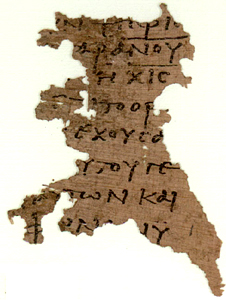
Irenaeus, bishop of Lyons) commented on Revelation 13:18 in Against Heresies, Book 5, chapters 29-30. In chapter 30, as Irenaeus calculates the number of the beast with various gematria calculations including his preferred “Lateinos” which means “the Latin one.” He then mentions that 666 is the number that is “found in all the most approved and ancient copies,” and he states that “those men who saw John face to face” have testified to its genuineness. Irenaeus then mentions the alternate-reading 616 and declared it to be a corruption:
six decads they will have it that there is but one. [I am inclined to think that this occurred through the fault of the copyists, as is wont to happen, since numbers also are expressed by letters; so that the Greek letter which expresses the number sixty was easily expanded into the letter Iota of the Greeks.] Others then received this reading without examination; some in their simplicity, and upon their own responsibility, making use of this number expressing one decad; while some, in their inexperience, have ventured to seek out a name which should contain the erroneous and spurious number.”
EARLIEST LATIN COMMENTARIES ON The 616 Number of the Beast
We are now certain that a variant from the number 666 existed very early in the history of the Church. It was verified in in Papyrus Oxyr. 4499 (also known as P115) from the Codex Ephraemi. We know that the earliest commentator to mention the existence of the 616 number was Irenaeus, who favored the 666 number. Therefore he made no attempt to interpret that number, but we will soon see the reason why he was unable to decipher this other number was because he wrote his commentary BEFORE Constantine’s conversion in 313 AD.
Tyconius Interpretation of 616
The first church father known to provide an interpretation to the 616 calculation is Tyconius of Carthage around the year 380. Tyconius was a North African Latin Theologian of the Fourth Century who was originally a Donatist but later excommunicated. There is no evidence he rejoined the Orthodox/Catholic Church but still he was very instrumental in influencing some of Augustine’s writings and many other Latin commentaries of the book of Revelation. Tyconius full Latin commentary on the Book of Revelation is titled Exposition to the Apocalypse. It was considered to be a lost commentary but has been fully reconstructed through other writings by later authors. It was recently translated into English as part of the Fathers of the Church Series by Francis X. Gumberlock in 2017. Tyconius was one of the first to present the book with an allegorical interpretation including the Amillennial view later adopted by Augustine. Tyconius believed the book was symbolically described the struggles facing the Church throughout the entire period between the Incarnation and the Second Coming of Christ. Latin commentators after Tyconius were certainly influenced by his commentary, and citations to his Exposition can be found by later Latin commentaries on the Apocalypse such as Primasius of Hadrumetum, Caesarius of Arles, the venerable Bede, and Beatus of Liébana.
Tyconius offers an interesting interpretation to the number 616 pointing to Jesus Christ and the “man” in the calculation as the Son of Man. This obviously would raise some eyebrows with many in the dispensationalist or preterist schools of thought but the consideration of the “Son of Man” as the man behind the number is ominous given the fact that the very next verse in the very next chapter 14 of the Apocalypse switches immediately to the vision of the “Lamb” standing on Mount Zion marking the foreheads of the 144,000 with his mark. This then ties in the possible references to the “man in linen” marking those in Jerusalem with the “tau” sign or mark in Ezekiel 9:4. Certainly we can see the timing was right in the period of the church, as it comes right after a period of history with Constantine the Great and the Edict of Milan in the year 313 AD, after commentaries from Irenaeus, Hippolytus and Victorinus, all of which preferred the 666 interpretation.
Constantine’s vision of the “sign” and subsequent “marking” for the Battle of Milan
In the spring of 312, Constantine led his army toward Maxentius in in Rome. The tradition of the church includes an account of a vision by Constantine the Great on the eve of the Battle over Milan Bridge. The day before the two armies would battle outside of Rome near the Milvian Bridge, Constantine had a vision instructing him to fight in the name of Christ, with his soldiers’ shields bearing the symbol of Christ. The vision above the sun was a sign of the Cross with the words “with this sign you will conquer”. The soldiers were directed to add the symbol on their shields which was either a cross or the labarum, an intersection of the chi (X) and rho (P), the letters of Christ. We read the following accounts:
Christian author Lactantius, writing several years after the battle, described: “Constantine was directed in a dream to cause the heavenly sign to be delineated on the shields of his soldiers, and so to proceed to battle. He did as he had been commanded, and he marked on their shields the letter Χ, with a perpendicular line drawn through it and turned round thus at the top, being the cipher of Christ. Having this sign (ΧР), his troops stood to arms.”
Eusebius in 337 write in the “Life of Constantine,” that Constantine saw a vision of a cross: “He saw with his own eyes the trophy of a cross of light in the heavens, above the sun, and bearing the inscription, CONQUER BY THIS. At this sight he himself was struck with amazement, and his whole army also, which followed him on this expedition, and witnessed the miracle.”

So now lets examine the 616 calculation and interpretation from Tyconius’s Exposition of the Apocalypse. Here is the translated text from Gumberlock’s commentary showing an interesting relationship of the Greek letters 616 to the earliest known Christograms known as the “Chi Rho“, which we find on pages 138 and 139:
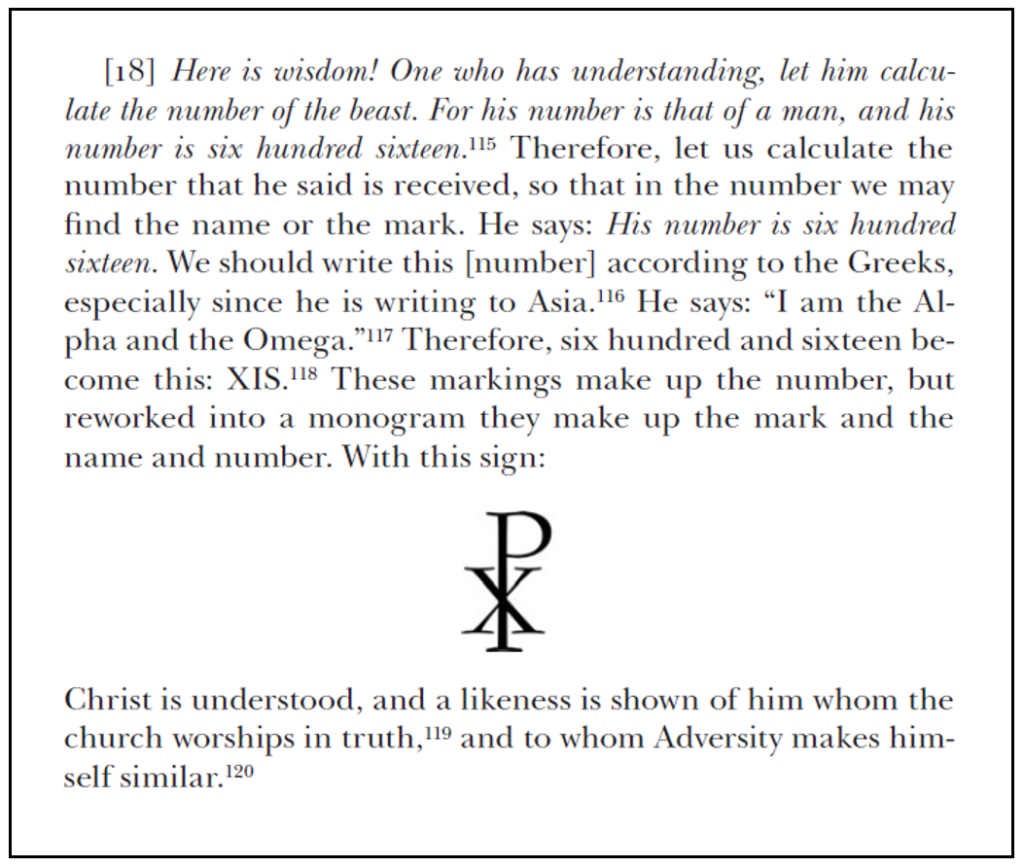
Wow! This is very interesting. Now lets once again examine up closely the Greek letters for the 616 from Papyrus P115:

First we notice these letters do in fact combine to make a Chi-Rho Christogram but in REVERSE order. So Tyconius is right, the numeric letters from the Papyrus 114 can be utilized and combined to take on a likeness of Christ. And Tyconius then says this is what the “Adversity” would make himself similar to.
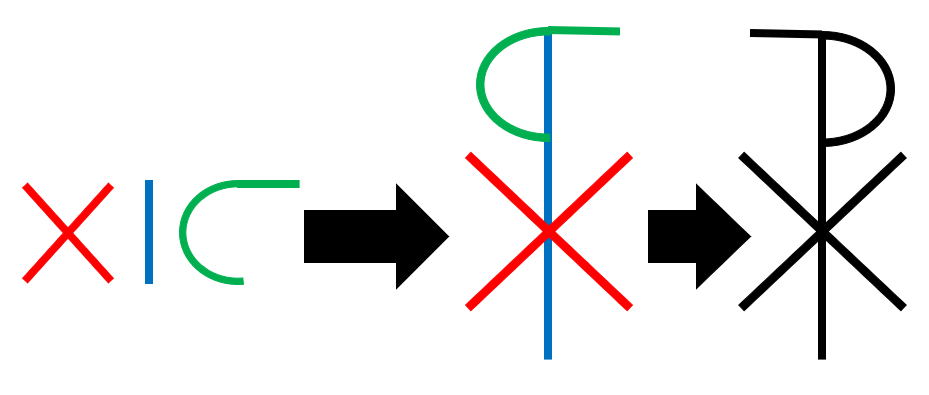
It has been suggested this “reversed Chi Rho” Christogram for the 616 calculation might have been the intended meaning for Tyconius. And if so, it could provide further evidence of the “marking” of the lamb-like second beast of Revelation 13 with a reversed variation of the image or Sign of the Cross (we will examine this a bit more later). This was discussed in the the year 1897 in the Proceedings of the Cambridge Philological Society, Issues 43-87 on page 6:
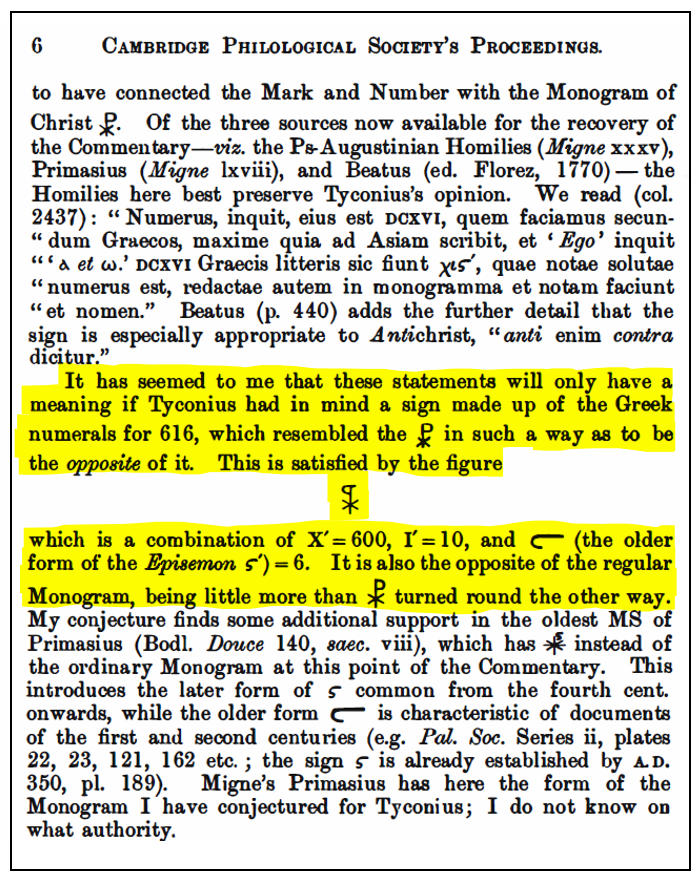
Before we expand on the interpretation of the Christogram a bit, lets look at more Latin commentaries at our disposal for additional clues on the meaning of the 616 number.
Caesarius of Arles Interpretation of 616
There is another 6th century Latin early church father commentary on the Apocalypse making a similar claim, and expanding upon the meaning slightly by St. Caesarius of Arles. St. Caesarius of Arles is recognized as a saint in both the Eastern Orthodox and Roman Catholic churches. He was Bishop of Arles from 502 to 542. He was considered the foremost ecclesiastic of his generation in Gaul. In all the Christian West, only Gregory the Great and Gregory of Tours overshadow him. The homilies on the Apocalypse were though to be compiled before the year 537. The principle sources behind his homilies are the commentaries of Tyconius and Victorinus, who he referred to them as “those who have more diligently commented” on the Revelation compared to the ancient church fathers. Caesarius takes on a more ecclesiastical interpretation to Revelation, interpreting many of the symbols to be related to the church, and understanding that the content of Revelation had to do with events which began immediately after the passion of the Lord and finding fulfillment to the day of Judgment.
It looks that Caesarius was in possession of early or ancient manuscripts of Revelation. He had the number of the beast as 616 and gives no indication that the number 666 was the alternative number. This begs the question if Caesarius had access to other manuscript rendering which Irenaeus referred to in his commentary. According to Caesarius, this number is not the number of the antichrist himself, but the number of Christ, the Son of Man. However he then clearly states that the lamb-like beast will take for himself the name of Christ among the heretics. Therefore, this passage is understood to be a sign of Christ and shows a likeness of him.
His interpretation on the 616 can be found in an English translation of his work titled “Exposition of the Apocalypse – The Continuation, (Homily 11), from Ancient Christian Texts – Latin Commentaries on Revelation, pp. 88-90. Here we read the following on the 616 calculation: (with critical portions highighted in yellow:

Eighth Century Commentary on the 616
Many commentaries on the Apocalypse were written in the early middle ages in the Latin West. One interesting commentary called ‘On the Mysteries of the Apocalypse of John‘ was part of a one-volume reference bible written around the year 750 in Northern France. This was recently translated into English for the first time by Francis X. Gumberlock in a book titled: “Early Latin Commentaries on the Apocalypse“. On Page 69 and 70 we find the following interpretation on the 616 expanding once again on the Christogram interpretation:

IC XC – The Christogram in Eastern Orthodoxy Contains 616/XIC
What is interesting to note, and I am not aware of any previous Greek or Latin commentaries on the 616 calculation that highlights this, is the fact that the most widely used Christogram in the Eastern Orthodox Church is the IC XC, which is ominously similar to the 616 letters XIC. The IC XC is a traditional abbreviation for the Greek word “Jesus Christ”. That is, the first and last letters of each of the words “ΙΗϹΟΥϹ ΧΡΙϹΤΟϹ“, with the lunate sigma “Ϲ” common in medieval Greek and the very same one used in the Papyrus 115 fragment). Now this obviously, in addition to the Chi Rho monogram interpretation proposed by Tyconius, provides further evidence that the man behind the mark and name is the “Son of Man” and “Lamb Standing on Mt Zion” of Revelation 14:1. How so? In traditional Orthodox iconography, this Christogram is often split: “ΙϹ” on the left of the image and “ΧϹ” on the right. It is sometimes rendered as “ΙϹ ΧϹ ΝΙΚΑ” (Ἰησοῦς Χριστὸς νικᾷ), meaning “Jesus Christ Conquers.” “ΙϹΧϹ” may also be seen inscribed on the Ichthys. Again, notice that these very same letters are contained in the 616 number: XIC, and the only difference is the C is used twice to construct the name of Christ in Greek: IHCOYC XPICTOC. In the full name, X is used once, I is used twice and C is used 4 times.
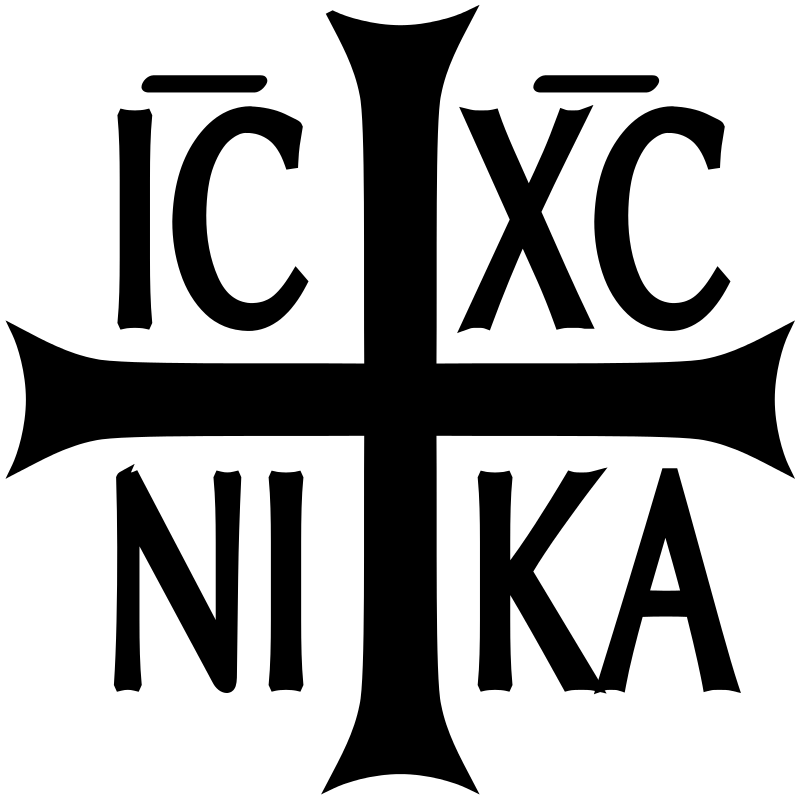
The IC XC is commonly found in all icons of Christ, as we see below in the Christ Pantocrator Icon
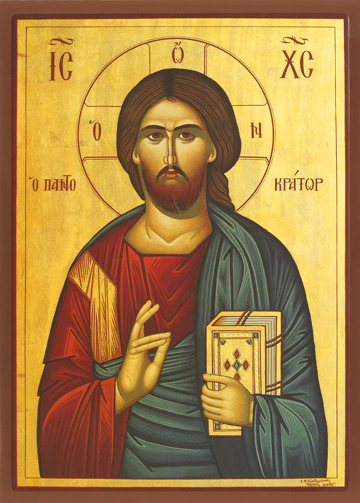
Now the plot thickens with respect to the text in Revelation on the “mark” on the “right hand”. If we notice many Orthodox icons of Christ he is making a Christogram with his right hand using the letters ICIX. You will notice this shown in the image below:

We can clearly see an association of the number 616 and XIC to the RIGHT HAND making a “SIGN”, a “MARK” and an “IMAGE of the name JESUS CHRIST using the letters IC XC! This brings to mind some scriptures in the Old Testament and the Apocalypse confirming the Right Hand of God is the “mark of the Lamb” pointing to Christ. Lets take a look.
The Mighty Right Hand of God serves as a Symbol on the Forehead
First we can find a close association of the Sign of the Cross in Deuteronomy:
“Hear, O Israel: The LORD our God, the LORD is one! You shall love the LORD your God with all your heart, with all your soul, and with all your strength. “And these words which I command you today shall be in your heart. You shall teach them diligently to your children, and shall talk of them when you sit in your house, when you walk by the way, when you lie down, and when you rise up. You shall bind them as a sign on your hand, and they shall be as frontlets between your eyes.“ – Deuteronomy 6:4-8 NKJV
Next we examine the passage in Exodus 13 which makes reference to the right hand of God to be used as a sign on the hand and symbol on the forehead of the Israelites through the sacrifice of the first-begotten lamb:
13 “You must redeem every firstborn donkey with a lamb. (…) And every firstborn of your sons you must redeem.
14 In the future, when your son asks you, ‘What does this mean?’ you are to tell him, ‘With a mighty hand the LORD brought us out of Egypt, out of the house of slavery.
15 (…) This is why I sacrifice to the LORD the firstborn male of every womb, but I redeem all the firstborn of my sons.’
16 So it shall serve as a sign on your hand and a symbol on your forehead, for with a mighty hand the LORD brought us out of Egypt.” – Exodus 13:13-16
This “mighty hand” is further described to us by the prophet-king David:
“The LORD said unto my lord, Sit thou at my right hand, until I make thine enemies thy footstool.” – Psalm 110:1
This imagery of the right hand is presented to us in Revelation 5 where the slain lamb comes to the right hand of God:
“And I beheld, and, lo, in the midst of the throne and of the four beasts, and in the midst of the elders, stood a lamb as it had been slain, having seven horns and seven eyes, which are the seven Spirits of God sent forth into all the earth. And he [i.e. the lamb] came and took the book out of the right hand of him that sat upon the throne. – Revelation 5:6-7
What is interesting is that this is very similar to the symbolism of Daniel 7 when the Ancient of Days approaches the Son of Man. Based on the writings of the early church fathers we can equate the Son of Man approaching the Ancient of Days when the “Word became Flesh”, that his the two natures and single hypostasis of Jesus Christ the Logos. The mark, therefore represents the lamb representing the image of the might right hand of God, Jesus Christ:
“We are also reminded that the “The Son is the image of the invisible God, the firstborn over all creation.” – Colossians 1:15
This image of Jesus Christ as both the slain lamb and the mighty RIGHT HAND of God was be used as a sign on the right hand and foreheads. This sign of a man is thus expressed with the 616/XIC, decoded by the early Latin church father commentaries on Revelation as the very SIGN OF THE CROSS and JESUS CHRIST though the XP and ICXC Christograms.
Ezekiel 9:4 is our final scripture passage we will examine which confirms this truth, and ties all of these related scriptures together in identifying the Son of Man Jesus Christ with the “mark of the Lamb. We find a reference to a mysterious “man of linen” in Ezekiel 9:4 marking a particular sign on the foreheads of men. We read:
“… And he called to the man clothed with linen, which had the writer’s inkhorn by his side; And the Lord said unto him, Go through the midst of the city, through the midst of Jerusalem, and set a mark upon the foreheads of the men that sigh and that cry for all the abominations that be done in the midst thereof.” – Ezekiel 9:3-4
This “man of linen” directed to go and mark the foreheads of men appears to be a similar description of the man “clothed in linen” we read in Daniel 12 making the oath, and this person can be identified as the Logos, the preincarnate Christ who was speaking to Daniel. If the “man in linen” is in fact Christ before the incarnation, then we have another direct reference of the sign of the cross to the “Lamb standing on Mount Zion” in Revelation 14-1 writing his name (XP, ICXC) on their foreheads Therefore, both Ezekiel 9:4 and Exodus 13:16 help us to correlate the very last verse of Revelation 13 providing the information for decoding the mark of the beast to the very next verse in the Apocalypse. And this verse is the “Lamb” standing on Mount Zion marking the 144,000 with the Sign of the Cross on the foreheads, based on the 616/XIC number as shown in Papyrus 115. This directs the reader to see that the number of Revelation 13-18 is a strong foreshadow to Revelation 14-1. So obvious, but yet we completely miss it and never make the connection, because we are so focused on the identity of the antichrist association with the number 666! The very animal symbol used to describe the second beast in Revelation 13 is a lamb. That lamb is the True Lamb standing on Mt Zion in Revelation 14, who is “the lamb of god who taketh away the sins of the world” with his death and resurrection on the Cross. We also have the association with the mark on the foreheads of the “man in linen” who is identified in Daniel 12 as the preincarnate Logos, himself sealing the ones in Jerusalem with the mark or “tau” letter, which was a symbol of the Sign of the Cross. So there you have it, the connection of the mark to Christ! This very same Sign of the Cross which was the “sign of the Son of Man in the heavens” in Constantine’s vision. The Chi Rho symbol, which is ominously visible when we combine the Greek Letters XIC of the number 616 to make the sign of the Cross.
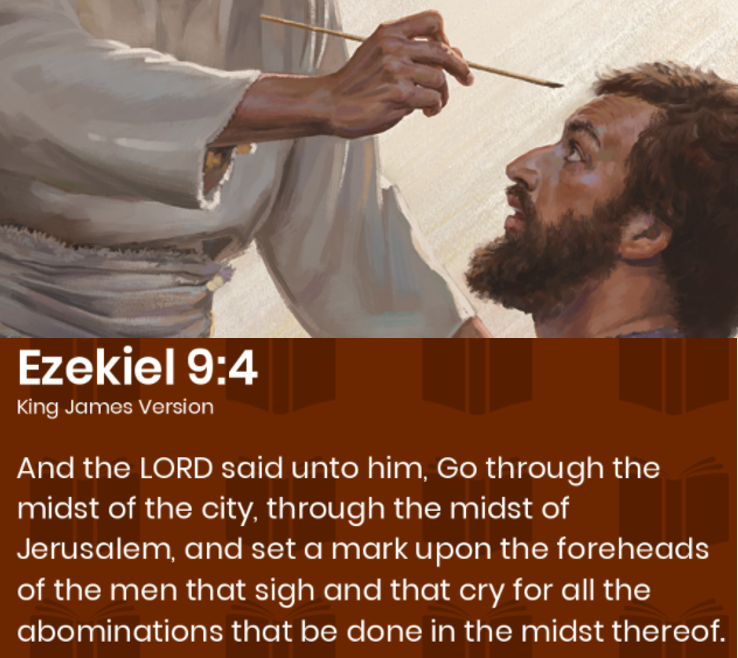
Many biblical commentators like St. Jerome have concluded that the mark of Ezekiel 9:4 was cross-shaped. St. Jerome says the mark was shaped like the last letter in the Hebrew alphabet, which, in its earliest forms had a cross-like shape.
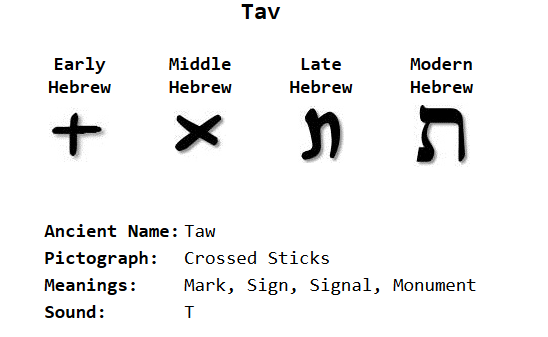
Tertullian (c. 160-225) also identifies the Tau (or “mark” and “sign”) with the Cross:
Premising, therefore, and likewise subjoining the fact that Christ suffered, He foretold that His just ones should suffer equally with Him–both the apostles and all the faithful in succession; and He signed them with that very seal of which Ezekiel spake: “The Lord said unto me, Go through the gate, through the midst of Jerusalem, and set the mark Tau upon the foreheads of the men.” Now the Greek letter Tau and our own letter T is the very form of the cross, which He predicted would be the sign on our foreheads in the true Catholic Jerusalem, in which, according to the twenty-first Psalm, the brethren of Christ or children of God would ascribe glory to God the Father, in the person of Christ Himself addressing His Father; “I will declare Thy name unto my brethren; in the midst of the congregation will I sing praise unto Thee.” For that which had to come to pass in our day in His name, and by His Spirit, He rightly foretold would be of Him – (Tertullian, Five Books Against Marcion, Book III).
This particular “mark of the Lamb” is identified with Chrismation. The saints of Revelation 7 and Revelation 14, the 144,000 are sealed with the sign of the Cross and marked with Christ on their foreheads. However, the second beast of Revelation 13, or the Apparent Lamb with two horns of power speaking like a dragon takes on the “image” of this beast in such a way that he presents a mirror image of Christ, rising to power with deception and miracles. In our previous post where we identified the power of Simon Magus and simony to the second beast, we offered the following quote from Father Inok Vsevolod (Filipiev) with identifying the anti-mark to the True Cross:
“In a spiritual sense, this satanic mystery – the imprinting of the mark of Antichrist – will be the antithesis of the Christian Mystery of Chrismation, which, we recall, is the placing of the seal of the Holy Spirit, while imitating its external form. Just as in the Mystery of Chrismation, the priest anoints the newly-illumined on the forehead and hands, so, too, in the placing of the mark of Antichrist, his servants may well anoint people with some kind of “sacred” oil, which will symbolize the voluntary acceptance of Antichrist and his religion.” – From the Orthodoxinfo article: Count the Number of the Beast: 666
Nero Redivivus
It is becoming clear that the number 616 played an important role in early commentaries of Revelation by early church fathers. Irenaeus mentions the number but he was too fixated on the 666 calculation. And rightly so. Irenaeus helped to identify the “Lateinos” 666 calculation which points to a Latin Leader (“the Latin One”) to come. As the disciple of the disciple of St. John the Theologian, did he have a clue from Polycarp on the identity of the Apparent Lamb? His primary focus seemed to be Rome. The same can be said for Hippolytus who also believed “Lateinos” was the correct calculation based on 666. What was causing Irenaeus to reject the 616 number? Well it seems perhaps, Irenaeus was completely sold on the concept of a “Nero Redivivus” figure. This legend began as soon as Nero died. The fear was that Nero was prophesied to come back from the dead one day to rule again in Rome. Was it possible perhaps that Irenaeus was sold on this legend of the Nero Redivivus, but did not want to explicitly call out the fact that Nero would come back from the dead? Why the obsession with the naming of “Lateinos“?
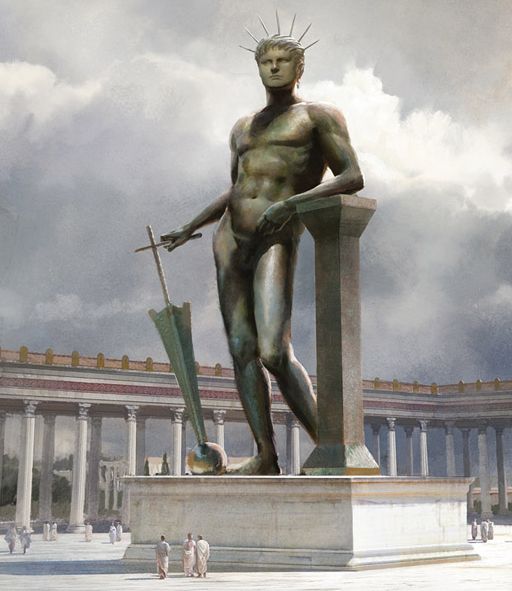
And we can see a close association with the city of Rome and Roman leaders will the following 666 and 616 calculations:
666 Calculation of Irenaeus and Hippolytus:
The Greek version of the name and title transliterates into Hebrew as נרון קסר, and yields a numerical value of 666, as shown:
| Λ | Α | Τ | Ε | Ι | Ν | Ο | Σ | Sum |
| 30 | 1 | 300 | 5 | 10 | 50 | 70 | 200 | 666 |
666 Calculation of Emperor Nero – Nron Qsr
The Greek version of the name and title transliterates into Hebrew as נרון קסר, and yields a numerical value of 666, as shown:
616 Calculation of Emperor Nero – Nro Qsr
The Latin version of the name drops the second Nun (נ), so that it appears as Nro and transliterates into Hebrew as נרו קסר, yielding 616:
| Resh (ר) | Samekh (ס) | Qoph (ק) | Vav (ו) | Resh (ר) | Nun (נ) | Sum |
| 200 | 60 | 100 | 6 | 200 | 50 | 616 |
Some speculate the number 616 was an error from a copyist and thus a careless mistake and wrote the stau, or stigma. Another theory is that a copyist assumed the beast to be Nero and perhaps adjusted the number from 666 to 616 to make that association easier to see. After Nero’s death there was a fear that he would revive and “come back to life” and return to claim power once again in Rome. This idea was promoted in the second century in the Sibylline Oracles, who wrote (referring to Nero), “The reprobate man shall disappear, and afterwards he shall return, equaling himself with God, but his pretensions God shall refute.” In the 200’s, Commodianus stated: “Nero shall have been raised from the underworld.” This idea was also promoted in the late 200’s by Victorinus of Pettau, who wrote a commentary on Revelation. Referring to Rev. 13:3, Victorinus wrote that John “speaks of Nero. For it is plain that when the cavalry sent by the senate was pursuing him, he himself cut his throat. This man, therefore, resuscitated, God will send as a worthy king to those who deserve him.” In the early Middle Ages (specifically, in the 700’s) Beatus of Liebana recycled much of Victorinus’ commentary, and likewise affirmed that the seven kings mentioned in 17:11 were seven Roman Emperors (starting with Nero). Beatus seems to have maintained that Nero was a model, or “pre-figure,” of the Antichrist. These prophetic writings appear to the stage for a return of some kind of Nero Redivivus figure who would once again rule with absolute temporal power over the Christians and persecute the saints as Nero did before him.
Well it seems we have a solution pointing to a Nero-like figure for both the 666 and 616. It is well documented that the number 616 also calculates to Nero’s name, with a slight variation of 666 which also can point to Nero. This is a common calculation interpreted and promoted by the Full Preterist schools of thought, who believe that Nero was the prophecied antichrist and that all prophecy was fulfilled in 70 AD. However, is it possible that Nero plays a role in identifying the Apparent Lamb with two-horns of power, ruling with religious and temporal authority? Most certainly we can make a case that the legend of Nero Redivivus was to be fulfilled once more with another figure which would have similar authority to be viewed as a type of “god” in which he would make an image to the beast and as a result of the abuse of this power persecute the “saints” as described in the apocalypse, in the very same city as Nero?
The answer to this question is obvious for those of us of course who ascribe to the Historicists school of thought. The Nero Redivivus is fulfilled in history with the rise of the Papacy in the 8th century as the Pontifux Maximus or Supreme Pontiff. Recall in the tradition of the church and the apocrypha that Nero is associated with the story along with Simon Peter and Simon Magus in the city of Rome. This story, whether true or legend, fits into to general narrative that there is a strong association within the Latin church that Simon Peter is the supreme head of the church and derives apostolic succession from St. Peter. The irony is that the bishop of Rome derived its power not from Simon Peter, but the other Simon, Simon Magus and through the power of Nero. He was to rule politically from Rome as well as religiously, coming as the Apparent Lamb with these two horns of power, but speaking through the power of the Dragon. And history records many of the sins of the pope and the many deaths as a result of those who refused to “make an image” to the “beast.” The Papacy rose to power in distinct stages to claim Papal Supremacy and Infallibility and Revelation 13 records the exact process this would happen over time. It would be principally through the power of simony as the Papacy performed various miracles through the sorcery of Simon Magus to accomplish this goal. Lets examine how:
- After the rise of the Mohammedean FIRST BEAST of the seventh century with seven heads and ten horns in the first part of Revelation 13, the SECOND BEAST was to appear on the scene exercising the same authority as the first beast before him, that is he would also rule supremely with political and religious authority for a period of “42 months” or 1260 years. This is described in Revelation 13 verse 11 and 12.
- The Papacy did “great wonders” and “fire from heaven”. Through this sorcery of simony he was able with the procurement of forged documents to claim supremacy. The Donation of Constantine, the Donation of Pepin and the Pseudo-Isidorian Decretals. These and other “miracles” like the Crusades convinced the Eastern Church to turn to the Papacy for help to be saved by the Ottomans as the Byzantine’s once great empire was in danger of collapsing. These are described in Revelation 13 verse 13.
- The Council of Florence is described in verse 14. The Byzantines having been convinced that the Papacy with the Crusades could save them from the Ottoman onslaught was asked to “make an image to the beast”, or recognize the Pope as the Supreme head of the entire Church. The phrase “image to the beast” is also another symbolic phrase to mean “Vicar of Christ” just as the phrase “like a lamb” in verse 11 is another term for “Vicar of Christ”.
- Verse 15 is the Filioque Controversy that ultimately lead to the Great Schism, but later provided the Papacy with unlimited powers after the fall of Constantinople and the failed reunification of the churches at the council of Florence. The Papacy had the power to “breath life” into the “image of the beast” so that the “image should both speak.” This is a symbolic and allegorical way of expressing the fact that with Filioque the Holy Spirit proceeds through the Son. As the “breath” is the Holy Spirt and the “image of the beast” is the Lamb of God who is an image of the invisible God. This also is doubly expressed to mean that with the procession through the son, the papacy was given authority to act as the sole final authority of matters of the Holy Spirt through Papal Infallibility, so that the “image of the lamb” or the Vicar of Christ is Infallible.
- Verse 16 and 17 further describes the powers of Simony of the Papacy through Papal Indulgences, selling of ecclesiastical titles, the Filioque and other forms of manipulation of “buying and selling” or “trading” of the Holy Spirit. These are what ultimately lead to the downfall of the Medieval Papacy leading the church into the Protestant Reformation and Age of Enlightment out of the Dark Ages of the Papacy.
- Verse 18 of course was the subject of this blog post. The man behind the 616 calculation is Jesus Christ, and the “image of the beast” who is “like a lamb” are key phrases to describe the Vicar of Christ.
This idea that the Papacy is one of the Beast of Revelation 13 is not a novel concept and has been proposed since the Dawn of the Protestant Reformation. In fact we can go much earlier to the writings of those in the 12th century like the Catholic Church’s own Joachim De Fiore who called the Papacy the Antichrist. The Eastern Orthodox historicist perspective is slightly different than the Western Historicist interpretations in that there is more of a focus on the fulfillment of the Second Beast as the Papacy, and not the First Beast, which is often interpreted by the early Western Reformers to be the Papacy. In previous articles we examined the Eastern historicist narrative that the Papacy is the fulfillment of the Second Beast of Revelation 13. For example, one article focused on the concept of the “buying and selling” of verse 13:17 through a few of the parables from the Gospels like the Parables of the Talents and the Ten Virgins, and through the testimony of a great Orthodox Saint (Seraphim of Sarov) who taught that the acquiring the Holy Spirit is the goal for every Christian, and this is synonymous to trading and settling accounts or “debts” with God. This concept of “trading” with the Holy Spirit is to be applied to Revelation 13, and not the literal hysterical interpretations of bar codes, chip IDs and vaccine “marks”. Next in Part II, we examined the biblical and apocryphal writings to identify and link the Rise of the Papacy with Simon Magus who traveled to Rome and the resulting practice of simony within the church. That is, the Papacy used deception and so called miracles of acquiring powers of the Holy Spirit through the forged Isidorian Decretals and the Donations of Constantine and Pepin to claim Religious Supremacy and Temporal Powers. Armed with these two horns of power, the Papacy was led down the path of manipulation of salvation and of the Holy Spirit through acts of simony, enforcement of the “Filioque” modification to the Nicene Creed, forced celibacy and trafficking of fake or stolen relics and most notably Papal Indulgences which led to the Protestant Reformation. And finally, we examined in Part III, the parallels of Ezekiel 9:4 “mark” and “tau” symbol with the “mark” of Revelation 13 and Revelation 14, showing that the “mark of the beast” is related on some level to the Sign of the Cross, even as an anti-chrismation symbol for the Second Beast of Revelation 13. That is, the “sign” or “mark” of Ezekiel 9:4 “tau” symbol which was a prefigurement to the Sign of the Cross, must be considered as part of an interpretation of the 666 mark as St. John the Theologian borrowed the same idea for marking the foreheads in Revelation 7, 13, and 14. The Ezekiel 9:4 verse and its significance remains a mystery to those claiming to correctly identify the mark of the beast as the Covid-19 vaccine. The vaccine is the latest idea for the obligatory mark or “forerunner” to the mark, just as was thought to be the case with older ideas for such a mark to allow the “buying and selling” and financing of loans such as credit cards, chip cards and digital tattoos which were thought to be a mark before the start of the pandemic. However, based on the critical evidence given to us in Ezekiel 9:4 on the nature of the mark, the mark of Revelation chapters 13 and 14 therefore MUST be interpreted in such a similar way to demonstrate its association to the Sign of the Cross, the very mark drawn on the foreheads in the Old Testament scriptures.
Conclusion
The calculation of 616 as identified by some of the church fathers provides strong evidence to make the case for the number 616 as being the legitimate number representing the mark and name of the man represented behind the pseudo-lamb beast of Revelation 13. The animal used to describe the identity of the second beast is in the form of a lamb. This is none other than the Lamb of God with the number XIC who took away the sins of the the world and stands on Mount Zion. Behold then the contradictory images presented to us by the Holy Spirit of God to St. John the Theologian. The Book of Revelation presents to us the True Lamb standing on Mount Zion with the 144,000 sealed with the sign of the IC IX Cross on their foreheads. The Apparent Lamb stands opposite the True Lamb sealing his followers with his own opposite mirror image and backwards sign of the Chi Rho to identify the “Lateinos” who desired all to “make an image to the beast.” The contradiction and opposite nature in the signs of the crosses we can find visibly today between the Eastern and Western churches. The True Lamb identifies his followers with the sign of the IC IX on the foreheads with holding three fingers, as equals, together, to represent the Holy Trinity while the other two fingers are bent to represent the dual nature of the True Lamb. The Apparent Lamb has altered reversed mirror image Sign of the Son of Man with an open right hand and crossing in reverse order (a mirror image) to identify the Lateinos who recognize him as the head of the Universal Church. The Apparent Lamb would rise to power through the craft and deceit of three forged documents establishing two horns of power, the temporal and religious, which allowed him to breath life to the image of the beast. The making of the image of the beast was successfully completed with the adoption of the Filioque and the declaration of Papal Infallibility, both of which manipulated the “trading” or “buying and selling” of the gifts of the Holy Spirt through simony to the small and great, rich and poor, and free and slave men.
Meanwhile many Orthodox Christians remain oblivious to the fact that time and experience has revealed the true calculation for the number of the beast as St. Andrew of Caesarea indicated, becoming drunk with the wine of the wrath of fornication given by the Mystery Babylon, still to this very day, as they continue to look for a future Antichrist to rule from Jerusalem for three and a half years. They still look for any and all signs of the coming apostacy from the Orthodox faith while encouraging the disobeying of bishops in favor of isolated geronda quotes as they are convinced the vaccine is the precursor to the mark of the beast. In reality, they have “missed the mark” on the identity of the second beast. But the time is coming soon when Orthodox Christians will be called to shake off the moral slavery of Babylon and make ready to welcome the approaching Kingdom of God, as they one day will celebrate and worship again in the resurrected New Jerusalem and the Square of that once Great City. “Repent, for the kingdom of heaven is at hand.”
© 2021 by Jonathan Photius

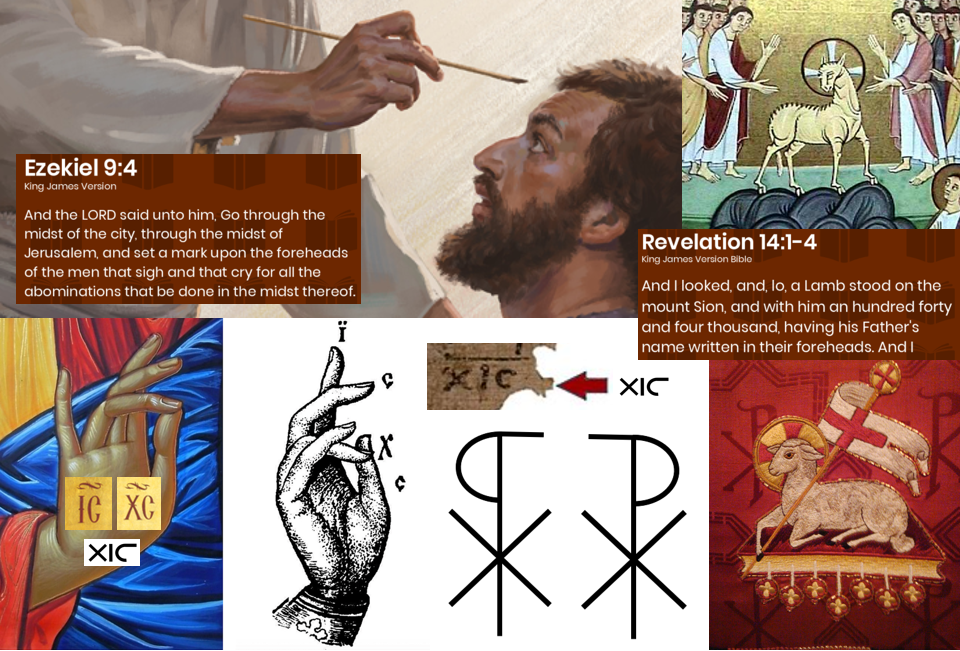
Thank you sir Jonathan
On Sat, Sep 4, 2021, 1:39 PM Neo-Historicism – End Times Eschatology From A New Eastern Orthodox Christian Historicist Perspective wrote:
> Jonathan Photius posted: ” Evidence from a fragment known as “Papyrus 115” > along with testimony from early church Latin commentaries on the apocalypse > reveal the number 616 (“XIC”) as a secondary (or perhaps even the primary) > calculation for the number of the beast. This alternate” >
LikeLike
Wow very interesting sir.
I’m confused tho, Yeshua was crucified according to the Bible and he was the image of God in the flesh correct?
Receiving the “mark” is basically worshiping the papacy?
Just digging for truth and understanding
Thanks
LikeLiked by 1 person